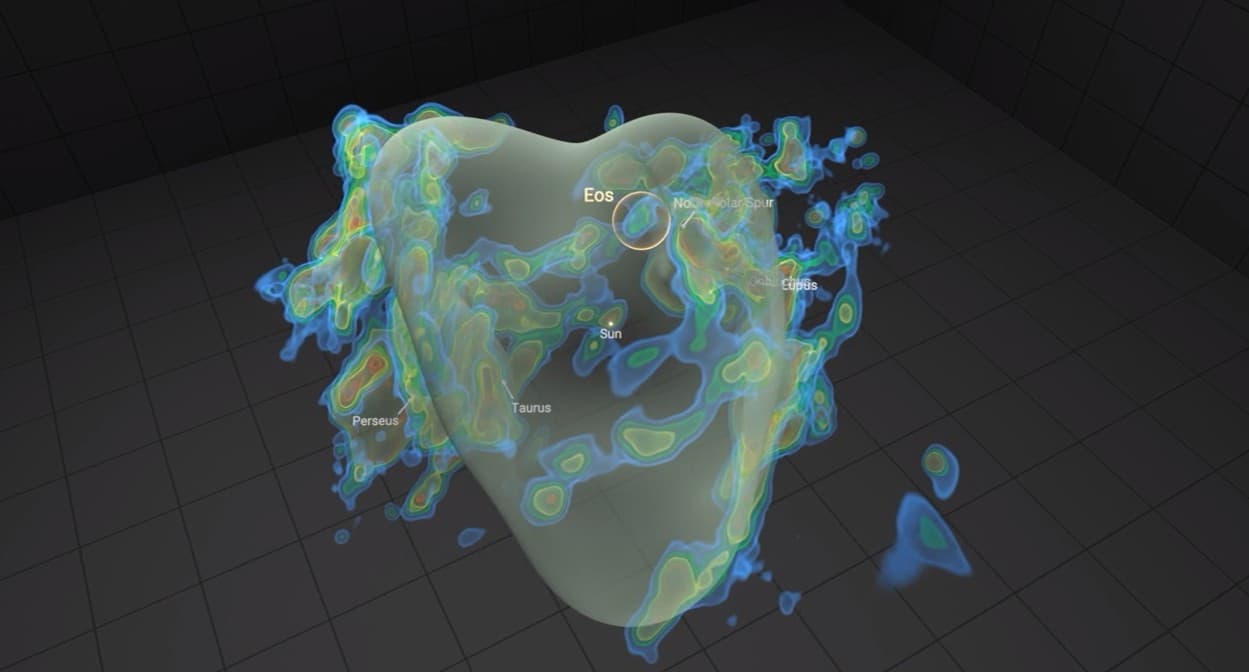(CN) — Astronomers have spotted a giant cloud of hydrogen gas hiding just 300 light-years from Earth — one of the closest ever found, and until now, completely invisible.
The crescent-shaped cloud, dubbed “Eos” after the Greek goddess who personifies dawn, was found by a team led by Rutgers University astrophysicist Blakesley Burkhart. Their study, published Monday in Nature Astronomy, describes Eos as a vast structure made mostly of molecular hydrogen — the key ingredient for forming stars and planets.
What makes the discovery stand out, researchers say, is how it was made: by detecting the cloud’s faint glow in far-ultraviolet light, something scientists weren’t even sure was possible.
“This is the first-ever molecular cloud discovered by looking for far-ultraviolet emission of molecular hydrogen directly,” Burkhart said in the news release. “The data showed glowing hydrogen molecules detected via fluorescence in the far-ultraviolet. This cloud is literally glowing in the dark.”
According to researchers, the cloud spans about 40 moon-widths across the sky and has a mass about 3,400 times of the sun. It’s located along the edge of the Local Bubble, a gas-filled cavity in space that surrounds the solar system.
Despite its size and proximity, Eos had gone undetected by traditional methods because it lacks carbon monoxide — the molecule typically used to identify these kinds of clouds. As a result, Eos is considered “CO-dark.”
Eos appeared in data from FIMS-SPEAR, a far-ultraviolet spectrograph that flew aboard the Korean satellite STSAT-1. The instrument captured ultraviolet light emissions from molecular hydrogen, splitting it into wavelengths that researchers could study.
Scientists have discovered a potentially star-forming cloud and called it “Eos.” It is one of the largest single structures in the sky and among the closest to the sun and Earth ever to be detected. (Thomas Müller (HdA/MPIA) and Thavisha Dharmawardena (NYU))
The data had been publicly released in 2023, and Burkhart spotted the glowing cloud soon after.
“It was kind of like just waiting to be explored,” she said.
Molecular clouds are the raw material of stars. They're made of gas and dust, mostly hydrogen, and usually found using radio and infrared signals — especially those from carbon monoxide. According to researchers, Eos breaks that mold, offering scientists a rare opportunity to study molecular hydrogen directly, and up close.
“When I was in graduate school, we were told that you can’t easily directly observe molecular hydrogen,” said Thavisha Dharmawardena, a NASA Hubble Fellow at New York University and co-author of the study, in the news release. “It’s kind of wild that we can see this cloud in data that we didn’t think we would see.”
Because of its proximity and unusual visibility, scientists say Eos could reshape how they study the interstellar medium, which is the gas and dust that fills the space between stars. This material eventually collapses to form stars, but the process isn’t fully understood. Eos offers a way to see that process more clearly, researchers say.
“Our discovery of Eos is exciting because we can now directly measure how molecular clouds are forming and dissociating, and how a galaxy begins to transform interstellar gas and dust into stars and planets,” Burkhart said.
According to researchers, Eos is expected to evaporate in about 6 million years, but in the meantime, scientists are using it to push the limits of detection.
Burkhart and her team have already published a preprint using James Webb Space Telescope data that may have captured the most distant molecular gas ever observed.
“Using JWST, we may have found the very furthest hydrogen molecules from the sun,” she said. “So, we have found both some of the closest and farthest using far-ultraviolet emission.”
Categories / SCIENCE
Subscribe to Closing Arguments
Sign up for new weekly newsletter Closing Arguments to get the latest about ongoing trials, major litigation and hot cases and rulings in courthouses around the U.S. and the world.
Additional Reads
A carnivorous ‘bone collector’ caterpillar dresses in the remains of its prey
April 24, 2025
Spaceship carrying 3 Chinese astronauts docks with Tiangong space station in latest crew rotation
April 24, 2025
Girl power! Researchers find female bonobos work together to keep males in line
April 24, 2025
Ancient ‘hell ant’ discovery rewrites evolutionary timeline
April 24, 2025
